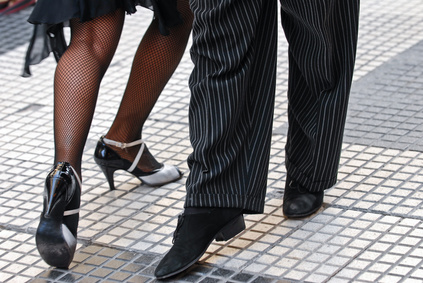 The tango is an evocative dance that has its origins in 19th century Argentina. It developed on the riverside, or ribera, of the Riachuelo River in Buenos Aires in the early 1880s. At the time, Buenos Aires was a city in expansion due to large numbers of immigrants coming from Europe in search of work. The majority of the new immigrants were single men, largely sailors and artisans by profession. To mitigate their loneliness many frequented brothels or burdeles with live music for entertainment. As the atmosphere was somewhat melancholy, undertones of longing, loss and separation are present in the music. The dance that developed is a slower, more intense and restrained version of the milonga, a dance that had previously been popular in the same circles, and features very intricate footwork and close partnering.
The tango is an evocative dance that has its origins in 19th century Argentina. It developed on the riverside, or ribera, of the Riachuelo River in Buenos Aires in the early 1880s. At the time, Buenos Aires was a city in expansion due to large numbers of immigrants coming from Europe in search of work. The majority of the new immigrants were single men, largely sailors and artisans by profession. To mitigate their loneliness many frequented brothels or burdeles with live music for entertainment. As the atmosphere was somewhat melancholy, undertones of longing, loss and separation are present in the music. The dance that developed is a slower, more intense and restrained version of the milonga, a dance that had previously been popular in the same circles, and features very intricate footwork and close partnering.
The tango reached a wider audience in the early 1900s, when it was brought to Paris, France by Argentinian sailors. By the years leading up to World War I it was a worldwide sensation. Upper class Argentinians back home that had previously turned their nose up at it due to its associations with criminals and the lower classes, now embraced it and the previously lewd lyrics were cleaned up. By the early 1930s the tango was in its golden age and no one person better epitomizes this era than the singer Carlos Gardel.
Born abroad in 1890, Gardel moved to Argentina at the age of two and grew up in the Abasto neighborhood of Buenos Aires. After having started his career singing in bars and private parties he soon rose to fame with his beautiful baritone voice and photogenic features. He began touring internationally in the 1920s and was wildly popular throughout Latin America. Unfortunately, his life was cut short when he died in a plane crash in 1935. His death at a young age has immortalized his image in Argentina. Luckily many of his recordings are still available for listening today. To view an original video clip of Gardel performing one of his most famous songs, Mi Buenos Aires Querido click here.
The tango remains popular today and tourists in large numbers descend on Buenos Aires every year to visit various venues in which to view live tango or even take lessons themselves. Opportunities to view the tango vary from impromptu dances on the streets to formal sit-down dinner shows featuring a variety of dancers and musicians. A student of mine who has recently returned from Buenos Aires highly recommends Bar Sur as THE place to go to see live tango in Buenos Aires.







